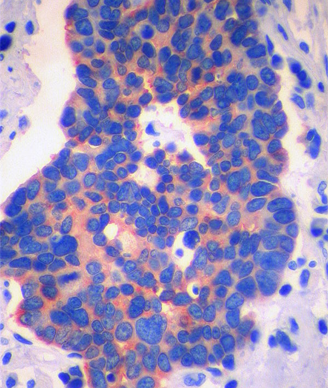Amrubicin Edges Topotecan for Survival in Refractory SCLC
In a new trial, amrubicin showed a slight improvement for patients with refractory small-cell lung cancer in the second-line setting.
Small-cell lung carcinoma, chromogranin immunostain; source: Yale Rosen, Wikimedia Commons

Amrubicin failed to improve survival over topotecan as second-line therapy for patients with sensitive small-cell lung cancer (SCLC), according to results of a new randomized phase III trial. There was, however, a small overall survival benefit seen in patients with refractory disease.
“SCLC is the most aggressive type of lung cancer,” wrote researchers led by Joachim von Pawel, MD, of Asklepios Fachkliniken München-Gauting in Germany. “Despite encouraging phase II results for many targeted therapies and newer chemotherapeutic agents, current large phase III trials have failed to show improvement compared with standard of care.” Currently, topotecan is the only approved drug for second-line therapy in SCLC patients sensitive to initial treatment; earlier work suggested the third-generation anthracycline and topoisomerase II inhibitor amrubicin could have strong activity in these patients.
The new study included 637 patients with refractory or sensitive SCLC, assigned 2:1 to amrubicin or topotecan. The median overall survival was 7.5 months with amrubicin and 7.8 months with topotecan, for a hazard ratio of 0.880 (95% CI, 0.733-1.057; P = .170).
Patients with sensitive disease also saw no difference between the drugs, with median overall survival of 9.2 months with amrubicin and 9.9 months with topotecan for a HR of 0.936 (95% CI, 0.724-1.211; P = .615. In refractory patients, however, there was a small but significant difference, with an overall survival for amrubicin patients of 6.2 months vs 5.7 months for topotecan, for an HR of 0.766 (95% CI, 0.589-0.997; P = .047). Notably, there are currently no approved second-line therapies for refractory SCLC patients.
There were also differences in the full cohort with regard to response rates, though they did not correlate with improved survival. A total of 31.1% of the amrubicin arm responded to the treatment, compared to only 16.9% in the topotecan arm (P < .001).
Treatment-emergent adverse events of at least grade 3 were less frequent in the amrubicin patients, at 74%, vs 89.3% for topotecan patients (P < .001). Neutropenia was the most common such event in both study groups; anemia, leucopenia, and thrombocytopenia were all less common in the amrubicin patients, though febrile neutropenia was more common.
This was the largest reported phase III study in this disease setting, the authors wrote. Though the primary endpoint of overall survival was not met, “the study showed a significant improvement in all secondary efficacy endpoints for amrubicin compared with topotecan.” Because of the dearth of treatment options in these patients, the authors concluded that “these results warrant further confirmation, and other studies are being considered.”
Newsletter
Stay up to date on recent advances in the multidisciplinary approach to cancer.